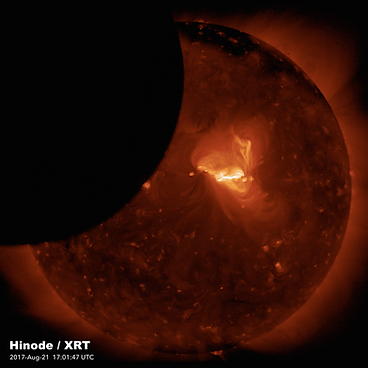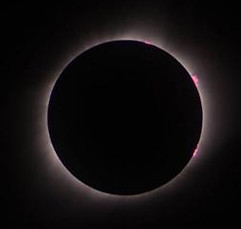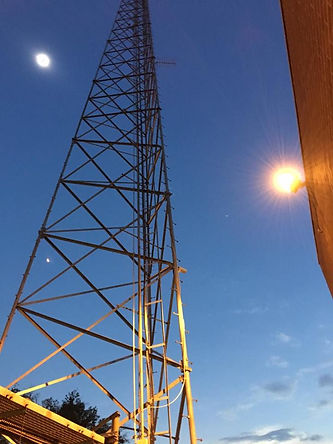All reports
September 2017 - Cassini Goes Down Swinging
Report #31 - August 2017
The Solar Eclipse

An image of the Moon passing over the Sun taken by the international Hinode solar observation satellite.
Credit: JAXA, NASA, SAO, NAOJ,
https://www.nasa.gov/sites/default/files/thumbnails/image/hinode_aug21.png
We don't have to elaborate for any American to know which solar eclipse we're talking about: the 2017 total solar eclipse that placed a shadow over a vast part of the continental United States on August 21st. The last time there was ever such a coast-to-coast eclipse in the area was nearly a hundred years ago in 1918!
This time around, millions of Americans had the opportunity of experiencing the breathtaking sight (with eclipse glasses, of course) as the Moon passed over the Sun. In the spirit and excitement of this astronomical event, we're bringing to you some interesting facts you probably didn't know or didn't think to look for as you watched the solar eclipse that Monday morning (0r afternoon).
The following is a summary of Forbes's Ten Surprises For Scientists And Skywatchers During The Total Solar Eclipse by Ethan Siegal, an astrophysicist and observer of the eclipse during complete totality.
"The Landscape Darkens Gradually, Not All At Once"
Many who may have not experienced complete totality during the eclipse might have expected the surroundings to blackout and go completely dark like some end-of-the-world cascading ominous dark shadow. However, according to Siegal, who was under the region of the eclipse known as the "penumbral region," the area not directly under the Moon's shadow, the "umbral," but the area around that 70-mile-wide path where the Sun's light's still very obscured, it was as if "everything was muted and greyed out, as though someone had literally placed a light filter over the world."
Parts of the Solar Corona Turned Pink!
Eclipse observers of the eclipse may have noticed pink on the edges of the Sun, or the solar corona. Siegal assures that this wasn't some trick of the eye, but the result of hydrogen atoms ionizing in the corona and those free electrons going through a series of transitions as they fall back into hydrogen nuclei, creating red lines, or flares. That, with the white light of the solar corona, is what produced the pink that was seen around the perimeter of the Sun. "The pink effect was real," says Siegal.

An image taken of the 2017 Solar Eclipse during totality.
Credit: Brett Boller,
https://www.forbes.com/sites/startswithabang/2017/08/22/ten-surprises-for-scientists-and-skywatchers-during-the-total-solar-eclipse/#7b5350472ba6
Venus Was the Only Planet Visible During the Eclipse
As seen by Siegal, "Just a minute or two before totality, the sky became dark enough that the planet Venus was visible to the naked eye." Unfortunately, while it would have been extraordinary to see, the umbral, or Moon's shadow, wasn't wide enough to expose the other planets.
Venus
An image taken of the 2017 Solar Eclipse and Venus.
Credit: Carol Goldsmith / WYFF News,
https://www.forbes.com/sites/startswithabang/2017/08/22/ten-surprises-for-scientists-and-skywatchers-during-the-total-solar-eclipse/#7b5350472ba6

"Only One Star Was Visible: Regulus"
Regulus may be the 21st brightest star in the night sky, but its closeness to the Sun (one degree from it!) was enough to make it the only one visible during totality.
The Horizon Turned Red
During totality, the horizon turned red even though the Sun was not rising nor setting. Normally, when sunlight enters our atmosphere, it's scattered from above us and it's scattered from all directions as far as the eye can see, giving a blue sky throughout no matter where you look. However, when sunlight is blocked in a large region near you while the light miles away from you at the horizon isn't, that distant light only scatters once before traveling through the atmosphere to you. During this process, the "first scatter," as Siegal puts it, "results in a slightly bluer light but still with lots of red, but then the majority of the blue light gets scattered away on its journey to [where you are standing]." It sounds a little complex, but it's this scattering of light coming from far away that makes it looks red to observers who are under the eclipses's shadow.
Some Observers From Oregon Got To See A Satellite During Totality
"Under the right conditions," satellites in low-Earth orbit become visible in the night sky. Nonetheless, even the conditions the 2017 solar eclipse was enough to reveal some satellites to observers in the right places. Observing from Amity, Oregon, Siegal was able to spot one of the Flock-2 Earth-monitoring satellites during totality. He described the sight as "a bright point of light very close to where the planet Mercury was expected. Yet it was both brighter than Mercury and was moving rapidly."
Temperatures Plummeted More Than Scientists Expected
During the eclipse, temperatures were only expected to drop by 5 to 12 degrees Fahrenheit. However, in Amity, Oregon, temperatures started at 82°F and decreased even as the Sun rose. By the time totality was over, it was a chilly 65°F in the area—a 17 degree drop.
Stay Tuned for the 2024 Eclipse!
If you enjoyed watching this solar eclipse, then you'll love the next one in 2024 that's expected to pass over continental United States. Because the Earth-Moon distance is predicted to be even smaller than it was during the 2017 eclipse, the solar eclipse in 2024 will to be darker, the "eclipse shadow [being] nearly twice as wide," and will last longer (more than four minutes in parts of Mexico and Texas!)
Maybe it's not such a bad idea to save those eclipse glasses after all.

An image of the 2017 Solar Eclipse.
Credit: Miloslav Druckmüller, Peter Aniol, Martin Dietzel, Vojtech Rušin,
https://svs.gsfc.nasa.gov/11995
SOURCES:
This report was a summary of the following article. Click the link for more information:
Images:
https://www.nasa.gov/sites/default/files/thumbnails/image/hinode_aug21.png
https://svs.gsfc.nasa.gov/11995